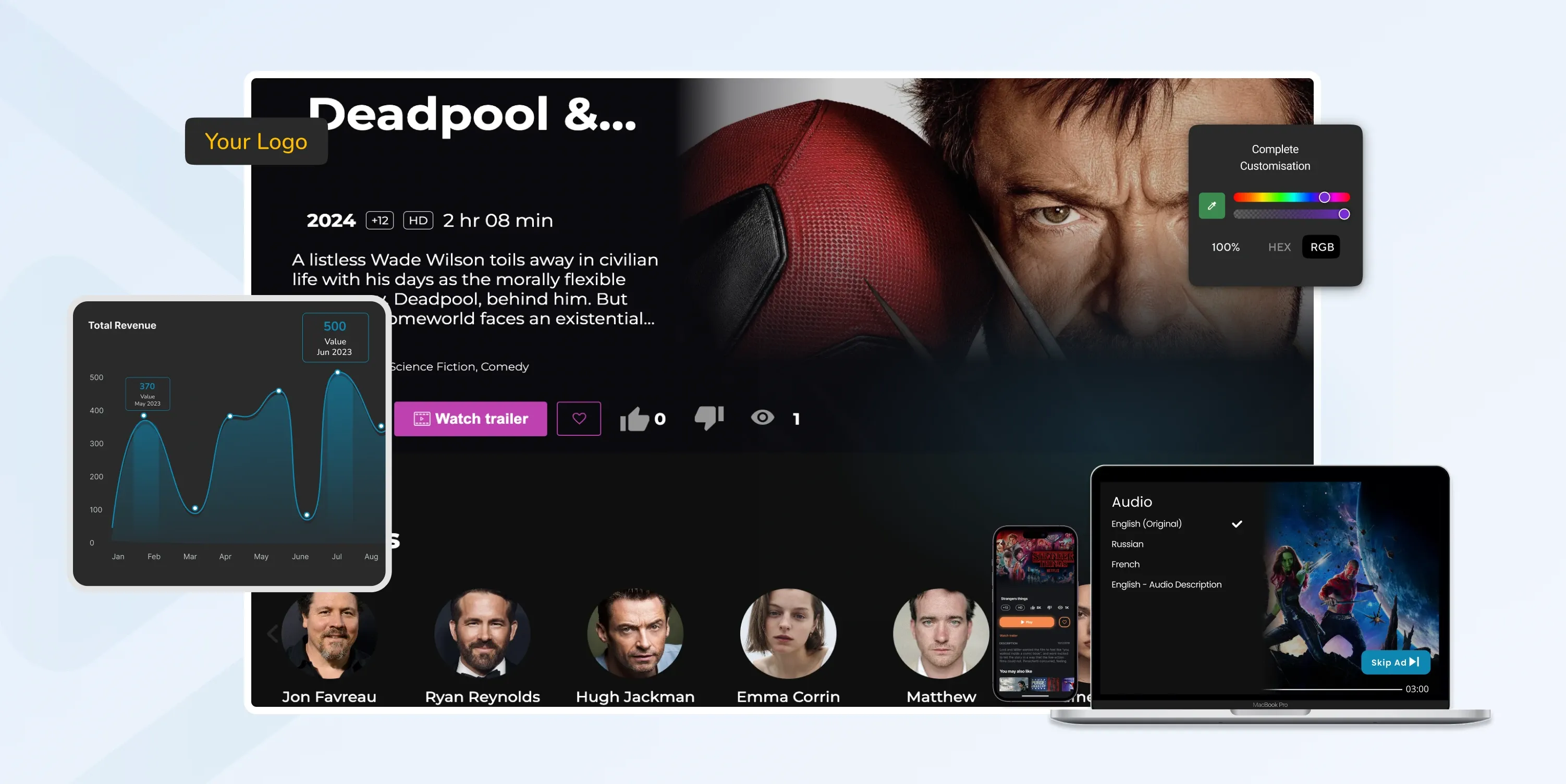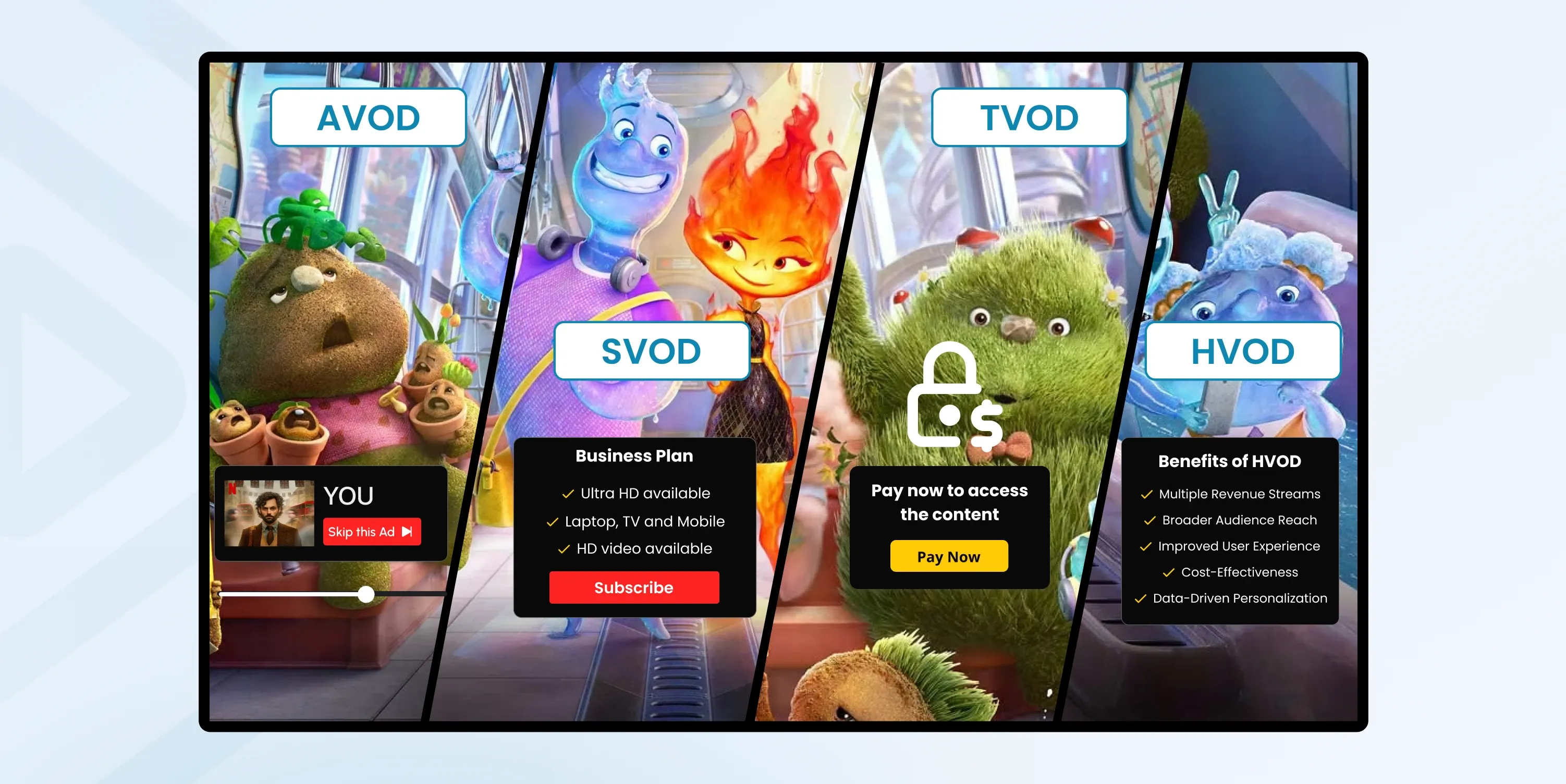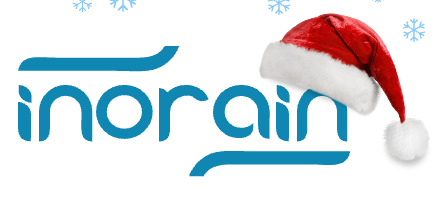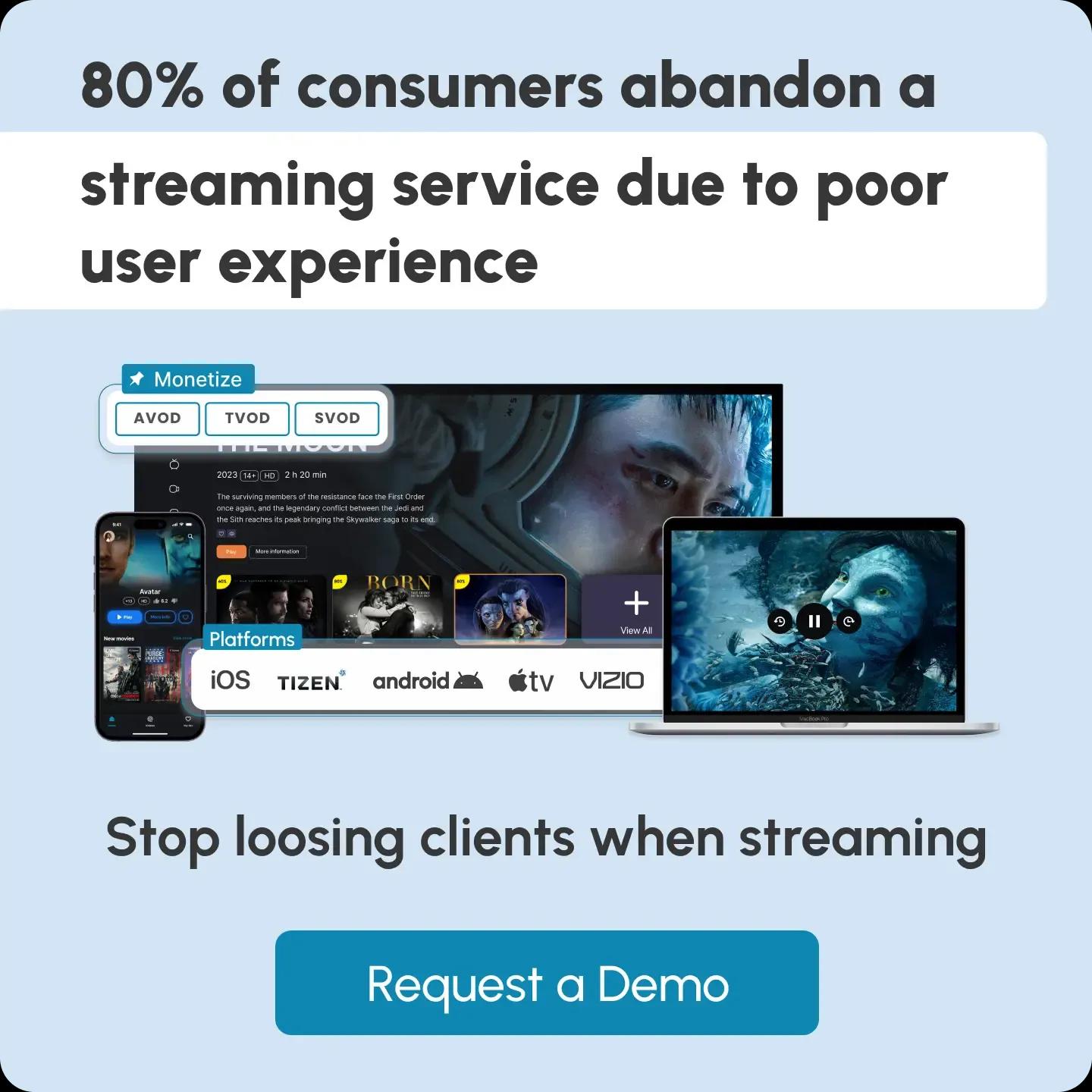
Custom OTT Platform Development: How to Start an OTT Business
Do you want to create your own OTT platform? If your answer is yes, then you need a sound plan, effective implementation, and a deep understanding of OTT development processes, from acquiring and licensing content to creating a reliable platform and choosing the right monetization strategies.
This guide has everything you need to know about the OTT ecosystem and how to start an OTT business.

What is an OTT Platform, and How Does it Work?
An OTT, or over-the-top, platform is an online service that delivers streaming content over the internet—directly to consumers' devices, such as smart TVs, TV boxes, PCs, smartphones, and tablets.
Popular OTT platforms like Netflix, Hulu, YouTube, WhatsApp, and Disney+ offer a vast variety of content, including videos, music, and even messaging capabilities. With an OTT streaming app, viewers can watch programs and shows anytime and anywhere.
OTT Market and Trends
OTT platforms have effectively bypassed traditional cable and satellite TV services.
This shift is driven by the growing demand for more flexible, on-demand viewing options, making it essential to stay updated on the latest trends and developments in the rapidly expanding OTT market.
In fact, evoca.TV estimates that more than five billion people will use OTT services in 2024, with just over 42% in the 18–24 age group.
OTT applications are beneficial with their flexible monetization options and different pricing models.
While subscription-based models (SVOD) dominate the market, ad-supported OTT platforms (AVOD) are also gaining traction. These platforms provide free content in exchange for targeted advertisements, appealing to price-sensitive consumers and those open to personalized ads.
According to Statista, OTT TV and video revenue is projected to hit over $76 billion in 2024 alone. Of that, the estimated AVOD revenue share will be $17.5 billion, while the SVOD revenue share is predicted to reach $53.5 billion. By 2029, the total number is predicted to reach an unbelievable $215 billion—double the figure reported for 2019.
OTT platforms invest in producing exclusive content. Shows like "Stranger Things" on Netflix (which is estimated to rake in ad-supported revenue of $4.6 billion in 2028) and "The Mandalorian" on Disney+ (with $11.4 billion in expected AVOD revenue by 2028), have become cultural phenomena—significantly boosting subscriber numbers and audience engagement.
The ability to offer unique, high-quality content has become a crucial differentiator in attracting and retaining viewers—something worth considering when you want to create your own OTT platform.
7 Types of OTT Platforms to Consider for Your Business
Before you start the OTT platform development process, it’s important to understand the various types of OTT platforms and their specific uses.
Here are the seven most popular types:
Video streaming platforms
Most OTT platforms offer video streaming services, and Netflix, Hulu, Amazon Prime Video, and Disney+ are some of the most common ones. These platforms offer various movies, TV shows, documentaries, and original content.
Live TV and Sports Streaming Platforms
OTT services like Sling TV, YouTube TV, and ESPN+ provide live broadcasts of TV channels and sports events over the internet, often including DVR capabilities, multi-screen viewing, and access to exclusive sports coverage.
Music Streaming Platforms
Spotify, Apple Music, or TREBEL Music are OTT applications that enable access to a vast catalog of songs and albums. They offer features such as curated playlists, personalized recommendations, and offline listening options.
News and Information Platforms
Platforms like CNNgo, BBC News, and Bloomberg TV deliver live news broadcasts and on-demand content related to current events, business news, and documentaries.
Fitness and Wellness Platforms
Peloton, Beachbody On Demand, and Daily Burn are some examples of fitness class studios that offer workout videos on demand, which users can stream from home or elsewhere.
Educational Platforms
Coursera, Udemy, and Skillshare provide online courses and training programs across various topics and skills, complete with video lectures, quizzes, and certifications.
Gaming Platforms
Internet gaming platforms like Google Stadia, Xbox Game Pass, or PlayStation Now are available on a range of devices. This means that anyone can play games online without necessarily having a console, and many people who love computer games appreciate the features these platforms offer.
Ultimately, choosing the right type of OTT platform depends on your business goals and target audience, offering different opportunities for monetization and audience engagement.
What are The Essential Features for OTT Platform Development?
In custom OTT platform development, several main factors can considerably improve the functioning, user experience, and competitiveness of your OTT application.
This table shows some features you can consider:
| Essential Feature | Description | Used For |
|---|---|---|
| Content Management System (CMS) | Manages video assets, metadata, categories, and user-generated content. | Organizing and delivering content efficiently. |
| User Sign-in and Login | Secure authentication via email, social media, or Single Sign-On (SSO); includes role-based access control (RBAC). | Providing user access control and security. |
| Content Delivery Network (CDN) | Ensures fast, seamless content delivery across devices, reducing buffering and latency. | Optimizing content streaming speed and performance. |
| Multi-Device Support | Ensures accessibility on smart TVs, smartphones, tablets, and desktops. | Offering a consistent user experience across all platforms. |
| Monetization Options | Supports SVOD (Subscription-based), TVOD (Transactional-based), AVOD (Ad-supported), in-app purchases, and payment gateway integration. | Generating revenue from content consumption. |
| Analytics and Reporting | Tracks user behavior, content performance, engagement, and revenue metrics. | Improving platform performance and decision-making. |
| Search and Recommendation Engine | Enables content discovery and personalized recommendations based on user history and preferences. | Enhancing user experience and engagement. |
| Offline Viewing | Allows users to download content for offline access. | Providing content access in low-connectivity areas. |
| Social Integration and Sharing | Connects with social platforms for content sharing, reviews, likes, and comments. | Increasing user engagement and content visibility. |
| Security and Digital Rights Management (DRM) | Implements security features to prevent piracy and unauthorized downloads; ensures content licensing compliance. | Protecting content from unauthorized distribution. |
| Live Streaming and DVR | Supports live event broadcasts and digital video recording (DVR) for user convenience. | Offering real-time content and time-shifted viewing. |
| Customer Support and Feedback | Includes FAQs, live chat, and feedback mechanisms to address user concerns. | Enhancing user satisfaction and platform improvement. |
How to Develop an OTT Platform? A Step-by-Step Guide
OTT platform development involves various steps that affect effectiveness, customer convenience, and conformity to market trends. Here’s a step-by-step guide to help you navigate through the OTT software development process:
Step 1: Define Your OTT Development Strategy
Conduct Market Research: Conduct thorough market research to identify your target audience and pinpoint market opportunities. Assess user preferences, demographics, and viewing habits to tailor your platform to the right audience. Analyze competitors' strengths and weaknesses to identify gaps your platform can fill.
Pick a Business Model: Choose the right monetization model to align with your content and audience preferences (SVOD, AVOD, TVOD, etc).
Implement a Content Strategy: Develop a content strategy that defines what type of content to offer—movies, TV shows, live performances, or niche programming—and how to source it for your OTT application.
Consider partnerships with content creators, licensing deals with studios, or producing original content. Determine a content acquisition plan that aligns with your budget and target audience's interests.
Step 2: Plan Your Platform Architecture
Choose a Tech Stack: Select scalable technologies with robust security measures that are compatible with various devices like smartphones, tablets, smart TVs, and web browsers. Consider using cloud-based solutions for scalability, microservice architecture for flexibility, and robust Content Delivery Networks (CDNs) for optimal performance and minimal latency.
Remember the Content Management System (CMS): The CMS should handle video assets, metadata, categories, and user-generated content, offering an intuitive interface for content creators and administrators.
Step 3: Design the UI and UX
Develop Intuitive UI/UX: Create user-friendly UI/UX mock-ups that prioritize user engagement and seamless navigation across all devices. The interface should be intuitive, with easily accessible content categories, search functionality, and personalized recommendations.
Ensure Responsive Design: Design a responsive layout that adapts to different screen sizes and resolutions, providing a consistent and visually appealing experience on smartphones, tablets, desktops, and smart TVs.
Incorporate accessibility features to ensure usability for all users, including those with disabilities.
Step 4: Implement Core Features
Integrate Secure Authorization Systems: Develop secure user authentication and authorization systems, such as Single Sign-On (SSO), two-factor authentication, and social login options, to protect user accounts and data.
Develop Subscription Management and Payment Systems: Implement a comprehensive subscription management system that supports various pricing tiers and billing cycles.
Integrate reliable payment gateways that offer multiple payment options, including credit cards, digital wallets, and in-app purchases.
Step 5: Create Information Management and Distribution Systems
Integrate Content Consumption and Delivery: At this stage of OTT platform development, implement efficient methods for content consumption, encoding, storage, and delivery.
Utilize adaptive bitrate streaming to ensure smooth playback across different network conditions. Optimize content delivery with a robust Content Delivery Network (CDN) to reduce buffering and improve load times.
Implement Metadata Management Systems: Integrate advanced metadata management systems to enhance content discovery and recommendations. Use AI and machine learning algorithms to analyze metadata and provide personalized content suggestions, improving user engagement.
Step 6: Integrate Analytics and Reporting
Use Analytics Tools: Integrate powerful analytics tools to monitor user behavior, content performance, and revenue streams. Track key performance indicators (KPIs) such as user engagement, churn rate, average watch time, and conversion rates.
Generate Actionable Reports: Create detailed reports that provide insights into platform performance and user preferences. Use these insights to refine your content strategy, marketing efforts, and user experience, ensuring continuous platform improvement.
Step 7: Implement Advanced Features
Leverage AI-Based Search and Recommendation Engines: Design advanced AI-driven search and recommendation engines to enhance content relevance and user interaction. These engines should analyze user behavior and preferences to provide personalized content recommendations, increasing viewer retention.
Include Social Features and Community Building: Enable social features like content sharing, user reviews, and community forums to foster engagement and build a loyal user base. Encourage user interaction through social media integration and in-platform social features.
Step 8: Ensure Security and Compliance
Choose the Right DRM Solutions and Data Security: Implement robust Digital Rights Management (DRM) solutions to protect your content from piracy and unauthorized distribution. Ensure your platform complies with data privacy laws like GDPR, CCPA, and other relevant regulations, providing secure data storage and handling practices.
Ensure Secure Payment Processing: This step of OTT development requires the implementation of industry-standard encryption and security protocols to protect user payment information and ensure secure transactions.
Step 9: Test and Conduct Quality Assurance
Start Functional and Performance Testing: Conduct comprehensive functional testing to ensure all platform features work correctly across different devices and operating systems. Perform performance testing to assess the platform's ability to handle large user loads, ensuring scalability and stability.
Establish User Acceptance Testing (UAT): During this step of OTT platform development, it’s time to involve a group of end-users in testing the platform to identify usability issues and gather feedback for further refinement.
Step 10: Launch and Iterate
Do a Soft Launch and Gather Feedback: Conduct a soft launch with a limited audience to test the platform under real-world conditions. Collect user feedback and usage data to identify any issues or areas for improvement.
Continuous Iteration: Use the insights you gained from the soft launch to iterate and enhance your OTT streaming app. Implement changes to improve the user experience, fix bugs, and optimize performance before a full-scale launch.
Step 11: Support and Maintenance
Ensure Robust Customer Support: Provide robust customer support options, including live chat, email support, and an extensive FAQ section. Offer prompt responses to user queries and technical issues to ensure a positive user experience.
Conduct Regular Maintenance and Updates: Schedule regular platform maintenance to address security vulnerabilities, update software components, and ensure compatibility with new devices and operating systems.
Continuously monitor platform performance and user feedback to make iterative improvements.
By following these steps, you can develop a robust, scalable, and user-friendly OTT platform that meets the needs of your audience and stands out in the competitive digital streaming market. If you need OTT platform development services, feel free to reach out—we’re here to help.
How to Monetize Your OTT Platform
 Here are some practical ways to monetize your OTT platform:
Here are some practical ways to monetize your OTT platform:
Subscription Video on Demand (SVOD)
Subscribers pay a regular fee (monthly, quarterly, or annually) for unlimited access to your content library. Popular platforms using this model to monetize their content are Netflix, Disney+, Apple TV, and Amazon Prime.
SVOD suits OTT platforms like educational platforms, sports events, fitness, health, and wellness. Your OTT application can offer different subscription plans (e.g., basic, standard, or premium) with varying content access levels and features.
Advertising Video on Demand (AVOD)
Advertising-based Video on Demand (AVOD) platforms allow users to access free content by incorporating advertisements during playback.
By integrating this model, your OTT streaming app can offer a variety of ad formats, such as pre-roll, mid-roll, and banner ads, while also providing advertisers with detailed analytics on viewer engagement and ad performance.
One of the most well-known AVOD platforms is YouTube, a video streaming giant with over 2.5 billion active users. Although signing up for YouTube is free, accessing content often requires viewers to watch ads before, during, or after their chosen videos.
Other popular AVOD platforms include Pluto TV and Tubi, which are particularly suited for OTT services that offer movies, TV shows, and serials.
This monetization strategy is ideal for OTT platforms looking to attract a wide audience while generating revenue through advertising.
Transactional Video on Demand (TVOD)
Transactional video on demand is an OTT video monetization model that allows users to purchase single pieces of content for a flat fee. This includes movies, television shows, and events, among other things.
There are three categories of TVOD:
- Pay-per-view (PPV): Subscribers view a particular show, event, or broadcast on a given channel at a certain time and pay once. This model is suitable when timeliness is involved, as with boxing events and sports.
- Electronic sell-through (EST): Users make single payments for periodic use of specific videos or events, such as an eLearning tutorial or a movie.
- Download-to-rent (DTR): Users pay to watch limited content, normally available 24 or 48 hours after the streaming begins. Some OTT platforms, such as Amazon Prime Video, use this pricing model.
Well-known TVOD-using platforms include Netflix, iTunes, Google TV, Sky Box Office, and Udemy.
Hybrid Models
A hybrid model combines SVOD, AVOD, and TVOD models to offer users flexibility and maximize revenue streams. OTT platforms design packages or bundles that combine subscription access with ad-free options or exclusive content.
The most common hybrid model is SVOD and AVOD. For example, Hulu offers free content interspersed with ads, but you can buy a premium subscription plan and watch ad-free content.
For any online video-sharing OTT application, choosing the right monetization strategy that aligns with the content, target audience, and market dynamics is essential for achieving long-term success—and growth—in the highly competitive digital streaming landscape.
Are you wondering how to build OTT apps without the high costs and hassles? Then, keep reading.
inoRain provides an end-to-end white-label OTT solution perfectly suited for every OTT business. With our customizable platform, you’ll get your very own OTT service designed with your branding, colors, logos, and terms—all without the high costs and time commitment typically associated with OTT platform development.
By choosing inoRain, you’re not just building a platform—you’re creating an immersive and engaging viewing experience that captivates audiences and drives business growth.
Visit inoRain today to learn more and start your journey toward digital streaming excellence!
Conclusion
Developing a successful OTT platform requires seamless content management, secure authentication, multi-device support, and monetization options. Advanced analytics, and DRM enhance user experience. Live streaming, DVR, and social integration boost engagement. If you’re looking for customized OTT platform development, inoRain offers specialized solutions to help you build a cutting-edge streaming service using industry best practices and innovative technologies.
Unlock the full potential of your streaming service and exceed user expectations with inoRain by your side. Contact us today and get your OTT business up and running.
Frequently Asked Questions
Co-founder / CTO
Armen is the CTO and Co-Founder of inoRain OTT and Co-Founder of HotelSmarters, specializing in advanced streaming technologies, OTT strategy, and interactive TV systems. He builds scalable end-to-end video delivery solutions and drives technical innovation across hospitality and streaming platforms, bridging complex engineering with practical business impact.

How to Make a Short Video App (2026 Complete Guide)
Learn how to build a short video app in 2026. Explore micro-drama trends, key features, monetization models, and step-by-step development insights.

OTT Advertising: Types, Best Practices, and Strategies
Over-the-top (OTT) advertising has transformed how brands connect with consumers.

VPlayed Alternatives: inoRain vs. VPlayed
Explore inoRain as a VPlayed alternative, comparing features, pricing, and OTT solutions to find the best platform for your streaming needs.

